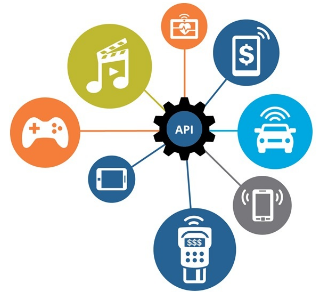Constant shifting left, which becomes unnecessary when using the method of continuous deployment, inevitably increases the amount of feedback from a QA department.
The problem with interfaces is that they are very slow and are not a good fit when developers need to know if their new build has broken the already written code. In this context, using API tests is a reliable and efficient solution.
Before analyzing a wide range of available tools for API test automation, let’s explain what are they actually like.

API Testing
What is API?
API (application programming interface) is a special type of specification that acts as an interface between special components of certain software.
A bigger part of functional testing is based directly on a user interface – various forms, web pages, processes. API tests avoid the parts of a user interface, interacting with applications and systems directly, by sending the requests to its API.
This type of testing helps to test the functionality of such popular technologies as databases, JMS HTTP, and web services.
Sometimes you can meet another name of this process – “headless” testing.
Most part of “headless” testing is based on omitting an interface and sending a request directly to the application’s back-end, receiving a response, and ensuring that everything works properly.
This is the easiest and simplest example of the way API (endpoint) testing is performed.
A client sends a request by contacting this resource. The request is sent, finds a necessary server and the server, in turn, executes the incoming request. When the necessary request is found, it is sent directly to the client.
And now we can talk about the tools that should be used while performing automated testing of endpoints.
Of course, we can work with proven Selenium but since it can be used for browser testing, it’s not a good fit for testing SOAP and REST.
REST-Assured
If Java is actively used on a project, REST-Assured is the most appropriate and efficient tool to automate the process of API testing. It’s the most popular tool among developers and testers.
REST-Assured is a rich and versatile Java library that can be used for testing the functionality of various REST services, built on HTTP protocols.
When it was developed, it became clear that it’s a good fit for testers who frequently automate various Java frameworks.
From a technical point of view, REST-Assured is a unique domain-specific language that helps to simplify the development of automated tests for Java-based products.
The presence of numerous template functions allows to start developing not from scratch.
The application supports XML and also JSON requests and responses.
Karate DSL
It’s quite a new automation tool that helps a tester to significantly simplify the development of various scripts for its BDD tests for testing the end-points. In contrast to numerous developed utilities and applications, when using Karate, you don’t need to create new steps and test scripts.
The software has created all necessary definitions that can be used for testing.
Karate DSL can definitely become a perfect tool that will be a good fit for an entire testing department as a basic utility that can help to create and execute numerous tests.
Its technical capabilities are aimed at the creation of a base of subsequent requests that are easily analyzed, to ensure that our expectations are met.
HTTPMaster Express
HTTPMaster Express is a specialized web development tool that can help to easily automate the functional testing of websites and related web services.
It can be used as the main tool for testing various REST services or API software.
It has also an option to rapidly track the incoming responses from API applications.
Characteristics of software:
- Can customize the client requests;
- There is an option to edit the established settings, connected to dynamic data;
- Works with a line of requests where the information from the first request is transmitted to another one and so on.
RestSharp
A simple REST and HTTP API client for .NET.
The peculiarities of the application:
- Completely supports the interaction with MonoTouch, Mono for Android, Windows Phone 10, NET 3.5+, Silverlight 5;
- Is easily mounted through NuGEt;
- Supports DELETE, HEAD, POST, OPTIONS.
REST Console
A universal HTTP client for creating and editing the requests, that allows testers to edit and debug the already created REST API.
Functions:
- Creation of request settings;
- Syntax highlighting settings;
- Working with Plain, OAuth+Custom authentication.
RoboHydra Server
A popular tool for testing clients, built on the basis of HTTP.
To not connect to a real server each time, you can simply connect the RoboHydra server and the application will respond in a proper way instead of you.
Peculiarities:
- Developed on Javascript and launched by Node;
- There is a possibility to test with the help of a group of various clients.
WebInject
An efficient solution with open software code that is suitable for various processes of automated testing of web applications and connected services.
Its distinctive feature is that it functions through a command line.
The utility is developed on Perl and is a cross-platform product, supported either on Windows, Linux, or Mac OS.
Pyresttest
It’s also an efficient tool to automate API testing with Python.
It helps to:
- Create a system of basic YAML/JSON tests in files that don’t require source software code;
- Return codes if a test fails;
- Create and edit a group of tests for Linux and Mac OS.
Airborne
Airborne is a framework built on Ruby, with open source code.
- Works with Rack utilities;
- Works with APIs that are developed on Rails.
Unirest
This tool is highly recommended as one of the simplest clients for testing HTTP requests.
It can be used together with xUnit for testing.
Mockbin
This product is recommended by Augusto Marietti as the most efficient tool.
By using it, you can easily generate your own group of endpoints for testing, simulating, and tracking HTTP requests and responses between the connected libraries, sockets, and API.
Features:
- Simulating its endpoints;
- Creating a group of HTTP methods;
- Logging and tracking the incoming group of requests to endpoints.
Apparently, the number of tools for test automation of endpoints is quite different and contains numerous tools and applications of a different type that can help to build a proper method of building processes of testing before pushing a web product to live.
Now we can talk about some peculiarities of API automation that should be taken into account.
The rationality of selecting API tests for automation
The first minor issues start when you select a necessary test case that will be used in the future in a test automation system.
Not each test case can be easily automated and frequently there are situations when tests should be executed manually. In other words, 10 % of 1000 tests can’t be automated.
Even when testing endpoints (API), sometimes it’s hard to move from manual testing to test automation.
Note: manual testing and automation are not mutually exclusive but mutually reinforcing.
Conclusion
Though we analyzed many disadvantages of API testing, we can’t be completely sure that avoiding automated tests is the best decision. They are always helpful.
Automation is efficient though has the same price.But to be completely sure that automated testing is really profitable, you should manage huge projects that have a complex logical and technical base.
And finally, indisputable advantages of automation:
- An automated test works faster than a human;
- The accuracy of an automated test is much higher;
- Automation will help to improve quality assurance;
- Automation can be used for any testing process;
- An automated test can be launched even at night when all testers are blissfully sleeping.










Leave A Comment